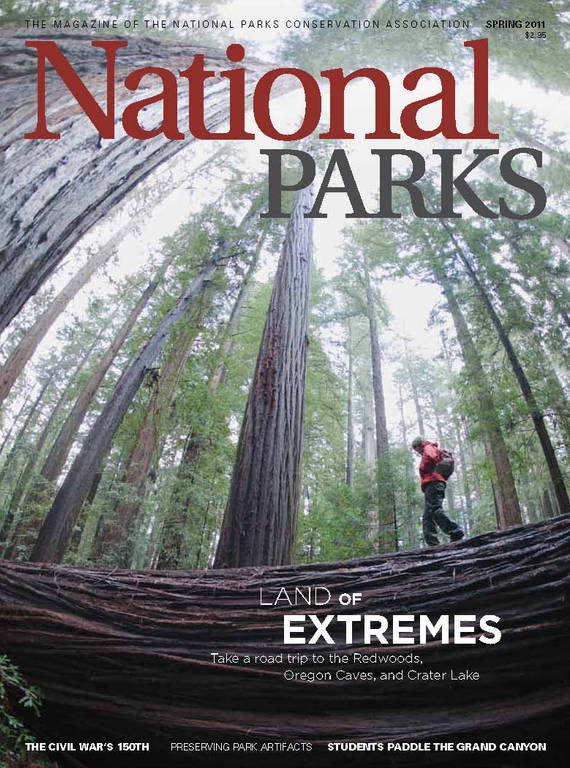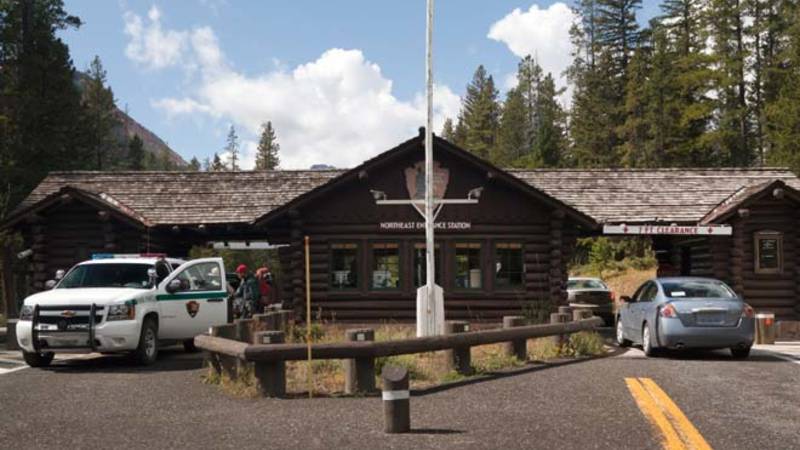Spring 2011
On the Road
Take a drive through the national parks of Oregon & California and witness a land of extremes.
On the southwestern corner of the Pacific Northwest, two national parks and a national monument sit within a stone’s throw of one another. One holds the deepest lake in the United States, with water so blue it makes the sky look plain. One claims the tallest trees in the world, their limbs reaching higher than 370 feet. And one is nestled within a region considered to have one of the highest rates of biodiversity in the country, teeming with life from tiny bacteria to large predators, ancient endemic beetles to endangered bats.
Individually, they are Crater Lake National Park, Redwood National and State Parks, and Oregon Caves National Monument. Combined, they offer my work-weary mind a vacation—a chance to shut down my computer and seek out Roosevelt elk resting in prairie grass, stealth spotted owls darting past thick tree trunks, red-legged frogs hiding among forest duff. I load my gear into the van and catch the unmistakable scent of damp soil, wet rocks, and ocean salt.
Redwood National and State Parks, California
TRAVEL ESSENTIALS
As I stand at the base of a downed tree in Humboldt Redwoods State Park, the top of my head falls a foot short of the trunk’s midpoint. Prone on the ground, the tree stretches almost 300 feet from root wad to tip—nearly a football field in length—and this coastal redwood isn’t even one of the giants of the Redwood National and State Parks (managed cooperatively by the National Park Service and California State Parks).
Populating a narrow strip of Pacific coastline between northern California and southwestern Oregon, coastal redwood trees grow from seeds smaller than that of a tomato to heights nearing 370 feet. They can live more than 2,000 years and have a 22-foot base diameter. Two hundred years ago these forests likely covered more than 2 million acres. However, after intensive logging from 1850 to 1970, only about 80,000 acres remain, and much of that is second-growth forest that was once logged but has been left to regrow.
The Park Service now protects about half of the total redwood forest. Nearly all of the remaining old growth—trees that have never been cut—is under federal or state protection.
I look for a route up the 10-inch-thick bark, which provided almost impermeable protection from insects, disease, and fire while the tree was standing. Gaining hold, I edge my feet carefully along the decaying wood. Inching up, following the curve, I make one big move and I’m on top of the trunk. I raise my arms and tilt my head back, searching out patches of sky amid the towering green crown that supports an entire ecosystem with a value to plants and wildlife that was largely unknown before the 1990s. Up there in the canopy, soil is being built from leaf litter and detritus. Hundreds of feet up, trees take root, ferns leaf out, and animals and birds—including the endangered marbled murrelet and the northern spotted owl—find refuge.
Reports on the development and growth of living matter in the Redwoods show that there is more living matter per square foot here than anywhere else sampled on the globe. Life is not just in the forestlands, however. The contiguous parklands include vast expanses of prairie, waterways, woodlands, and seashore; park boundaries actually extend offshore into the Pacific Ocean about a quarter of a mile.
Leaving the trees, I drive past open prairies where herds of Roosevelt elk forage on tall grass. I make my way to Enderts Beach outside Crescent City, California. An overlook provides opportunities for whale watching and observations of other marine life including harbor seals, sea lions, and a host of seabirds. At low tide I clamber onto a jagged black outcropping within the intertidal zone. Chilling fog creeps up the cliffs and heads inland toward the coastal range. Zipping my raincoat to my chin, I inhale once more, a big salty breath. Then I turn north toward shadow and mystery.
Oregon Caves National Monument, Oregon
The lights go out, plunging us into complete darkness. What remains is an unearthly quiet punctuated by small breathing noises and the occasional whisper of water dripping into small pools. The blackness affects my balance and I reach out with one hand, looking for someone or something to hold on to.
“We literally see people, families, getting closer, drawing nearer to one another,” says George Deems Herring, chief of interpretation at Oregon Caves. “There is a special dynamic that is inherent to a cave. It is a landscape that serves to form and strengthen bonds within families and sometimes strangers. You’re going down into a dark hole and seeing things. There’s an eerie beauty here that exists nowhere else in our normal human experience.”
Oregon Caves National Monument is tucked into the Klamath-Siskiyou Mountains, 4,000 feet above sea level. Created by naturally acidic rainwater and snowmelt draining through the soil that forms a carbonic acid solution and eats away at the marble and limestone bedrock, it is one of the few marble caves in the world, and it offers the unique opportunity to see both chemistry and geology in real time.
Minerals transported in the carbonic acid solution and deposited elsewhere in the cave can develop into new rocks and formations. These slow-growing “speleotherms” can look like sharp, pointed teeth guarding portions of the cave as they hang from the ceiling as stalactites or protrude up from the floor as stalagmites. Combined with the dampness, darkness, and cool temperatures (the cave stays a relatively constant 44 degrees Fahrenheit year-round), speleotherms heighten the feeling of foreboding that permeates much of the cave.
I follow a tour group back toward the entrance, stopping to look at the bones of a long-dead grizzly bear and listen to stories of ancient saber-toothed tigers that stalked this area. We climb out of the tunnel toward daylight, and I notice that indeed many people are walking closely together, holding hands. The air tastes sweet and dry.
In contrast to the drab grays, browns, yellows, and whites of the cave, the trail network that surrounds the park is strikingly green. Port Orford cedar, Douglas fir, and Manzanita grow thick and lush. Black-tailed deer crowd the trail before bounding up the steep hillside. The area is known for its high rate of biodiversity, and it may be that the region’s size is the key to the success of the plants (about 3,800 different species) and animals (about 50,000 different species).
I wander the trails, soaking up the vivid greens and warm browns of the forest. The sky above is bright blue through the clouds, prompting me to continue north toward one of the bluest places in the world.
Crater Lake National Park, Oregon
SIDE TRIP
A half-day’s drive from Oregon Caves, Crater Lake National Park sits on the edge of the Cascade Mountain range in southern Oregon, creating part of the transition zone between Oregon’s arid dry east side and its wetter, mossier west side. Rangers at the park talk about the inspiring qualities of the lake. For hundreds of years, they say, the lake has provided fodder for humanity’s scientific and creative minds.
Crater Lake wasn’t always a lake. Approximately 7,700 years ago, Mount Mazama underwent a violent volcanic eruption that was followed by the inward collapse of the upper portion of the 12,000-foot mountain. The collapse formed a giant caldera, which eventually filled with rain and snow water to form Crater Lake—the deepest lake in the nation, and also one of the clearest.
The eruption was likely one of North America’s most turbulent volcanic events of the last 640,000 years, a period of great volcanic activity along the Pacific Rim. Subsequent smaller eruptions at Mount Mazama created Wizard Island, a small cinder cone that protrudes from the lake. The area is now considered dormant, but the park is covered in reminders of its fiery past.
I’m normally in constant motion, but at Crater Lake I’m drawn to stillness. Scientists have measured the depth of the lake to almost 1,950 feet—deep enough to stack six Statues of Liberty on top of each other from base to torch tip. The water’s clarity allows visibility down to 120 feet on average. From my spot on the rim, it’s like looking into a liquid sky.
The lake’s sapphire color is a result of the water’s clarity, purity, depth, and how sunlight interacts with those factors. Water molecules absorb longer wavelengths of light (light that we see as red, oranges, yellows, greens) and reflect and scatter shorter wavelengths of light (the blues, indigos, and purples). The purity of the lake, coupled with its depth, creates an environment primed to enhance this scattering. The results are shades of blue rarely seen in nature.
An alpine wind and gathering clouds prompt me to give up my perch. The 90 miles of hiking trails in the park offer warmth through motion, and on my walk I hope to see an American pika, a small mammal related to a rabbit, with teacup-like ears. Pikas live in cool to cold climates and have long inhabited the high, rocky slopes of the park—but this could be changing. Park rangers and scientists are studying the impact of climate change on the population in the hope of protecting the species from declines in suitable habitat.
I look for pikas on the sides of the trails and up the rocky slopes, but my attention is pulled again and again to the larger view of giant redwoods stretching into the sky as if they would touch the sun. My mind wanders back over the landscapes I’ve visited to reflections of giant cumulus clouds in Crater Lake’s deep waters and the earthy scent of wet limestone exhaled from the depths of Oregon Caves. These parklands, and their quiet offerings, have reminded me of a greater, messier, more beautiful world than the one on the computer screen. It’s a world in which the meeting of science and mystery results not in conflict but in wonder—and I’m happy to be part of it.
Can’t wait to visit the Redwoods in person? Watch a short, moving video to experience these giants and learn the language of their ancient forests.
About the author
-
 Aimee Lyn Brown Contributor
Aimee Lyn Brown ContributorAimee Lyn Brown is a freelance writer in Oregon. She spent her childhood in the Pacific Northwest, and made her first trip to Crater Lake National Park before she could walk.


